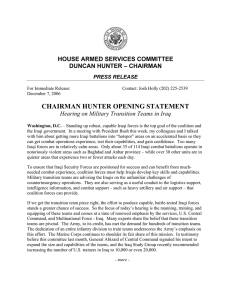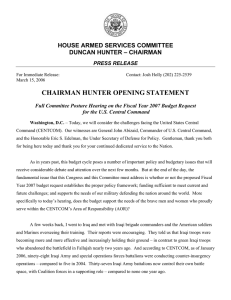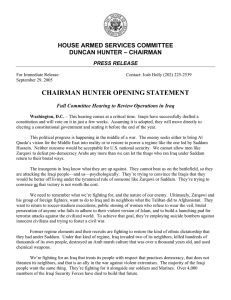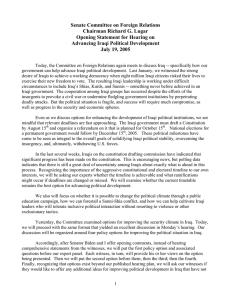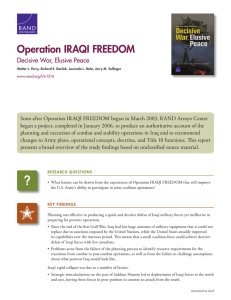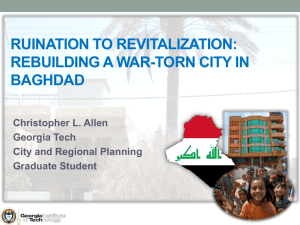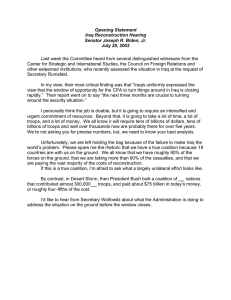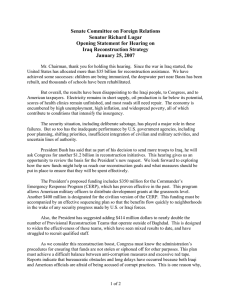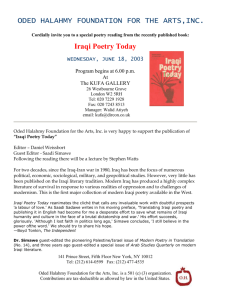TESTIMONY 6
advertisement
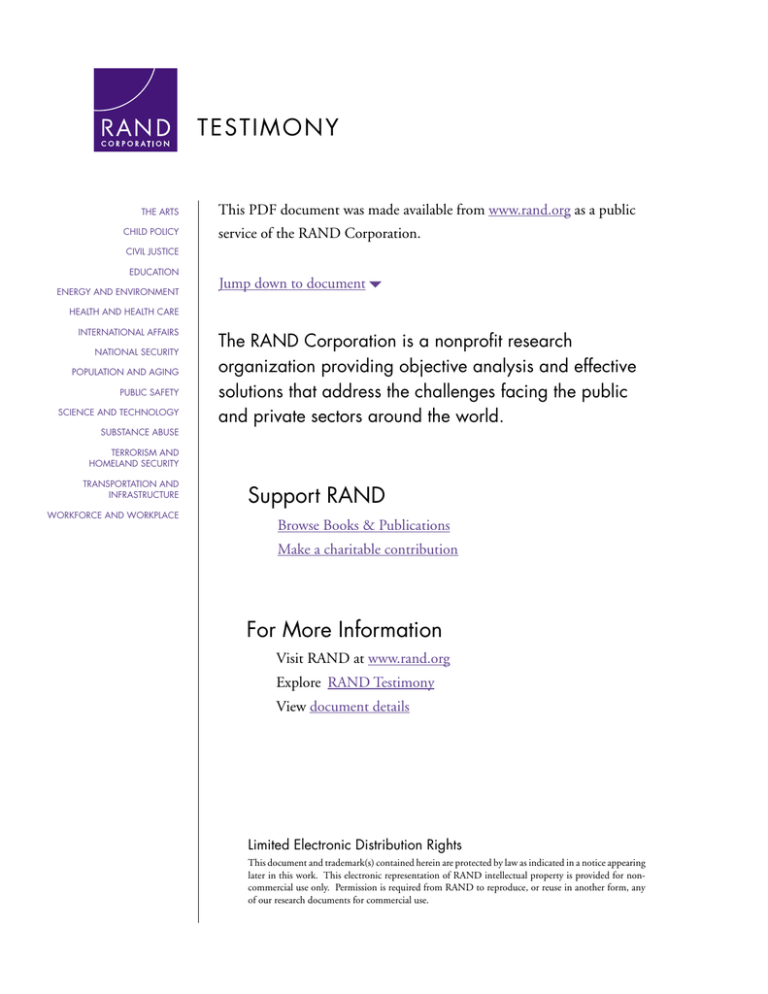
TESTIMONY THE ARTS CHILD POLICY This PDF document was made available from www.rand.org as a public service of the RAND Corporation. CIVIL JUSTICE EDUCATION ENERGY AND ENVIRONMENT Jump down to document6 HEALTH AND HEALTH CARE INTERNATIONAL AFFAIRS NATIONAL SECURITY POPULATION AND AGING PUBLIC SAFETY SCIENCE AND TECHNOLOGY SUBSTANCE ABUSE The RAND Corporation is a nonprofit research organization providing objective analysis and effective solutions that address the challenges facing the public and private sectors around the world. TERRORISM AND HOMELAND SECURITY TRANSPORTATION AND INFRASTRUCTURE WORKFORCE AND WORKPLACE Support RAND Browse Books & Publications Make a charitable contribution For More Information Visit RAND at www.rand.org Explore RAND Testimony View document details Limited Electronic Distribution Rights This document and trademark(s) contained herein are protected by law as indicated in a notice appearing later in this work. This electronic representation of RAND intellectual property is provided for noncommercial use only. Permission is required from RAND to reproduce, or reuse in another form, any of our research documents for commercial use. TESTIMONY Iraqi Security Forces Defining Challenges and Assessing Progress OLGA OLIKER CT-277 March 2007 Testimony presented before the House Armed Services Committee, Subcommittee on Oversight and Investigations on March 28, 2007 This product is part of the RAND Corporation testimony series. RAND testimonies record testimony presented by RAND associates to federal, state, or local legislative committees; government-appointed commissions and panels; and private review and oversight bodies. The RAND Corporation is a nonprofit research organization providing objective analysis and effective solutions that address the challenges facing the public and private sectors around the world. RAND’s publications do not necessarily reflect the opinions of its research clients and sponsors. is a registered trademark. Published 2007 by the RAND Corporation 1776 Main Street, P.O. Box 2138, Santa Monica, CA 90407-2138 1200 South Hayes Street, Arlington, VA 22202-5050 4570 Fifth Avenue, Suite 600, Pittsburgh, PA 15213 RAND URL: http://www.rand.org/ To order RAND documents or to obtain additional information, contact Distribution Services: Telephone: (310) 451-7002; Fax: (310) 451-6915; Email: order@rand.org Olga Oliker1 Senior International Policy Analyst The RAND Corporation Iraqi Security Forces: Defining Challenges and Assessing Progress2 Before the Committee on Armed Services Subcommittee on Oversight and Investigations United States House of Representatives March 28, 2007 Chairman Meehan, Ranking Member Akin, and distinguished Members of the Subcommittee: I appreciate the opportunity to be here today to discuss this important issue. Today I plan to discuss the Iraqi security forces, their status and development to date, and what we might want to know in the future to better assess progress. Counting Security Forces No one knows how many Iraqi security personnel there are today. The Pentagon can tell us that as of March 21, 2007, 329,800 Iraqi security personnel had been “trained and equipped,” however, this number counts only how many Ministry of Defense (MoD) and Ministry of Interior (MoI) personnel have completed Coalition training programs. While it can tell us whether or not the Coalition is meeting its training targets, it doesn’t tell us how many Iraqis are in uniform. It does not take into account deaths, desertions, or Iraqi police who are on the job but have not received Coalition-sponsored training. It fails to convey the fact that some quarter of military personnel and unknown number of police aren’t at their jobs at any given time (they’re on leave, taking their paychecks home, or just not there). Nor does it include thousands of other agents of the government in uniform and with guns. Iraqi officials are also not sure how many security personnel there are today. They may be able to calculate whom they are paying, but the fact is that they’re still paying some unknown number of people who aren’t actually working. Moreover, the Ministry of Finance pays the bulk of Iraq’s 1 The opinions and conclusions expressed in this testimony are the author’s alone and should not be interpreted as representing those of RAND or any of the sponsors of its research. This product is part of the RAND Corporation testimony series. RAND testimonies record testimony presented by RAND associates to federal, state, or local legislative committees; government-appointed commissions and panels; and private review and oversight bodies. The RAND Corporation is a nonprofit research organization providing objective analysis and effective solutions that address the challenges facing the public and private sectors around the world. RAND’s publications do not necessarily reflect the opinions of its research clients and sponsors. 2 Significant portions of this testimony are drawn from Olga Oliker, “No Law and No Order,” Parliamentary Brief, December 2006. The most recent numbers and data are from the “Iraq Weekly Status Reports,” produced by the Bureau of Near Eastern Affairs of the United States Department of State and available at http://www.state.gov/p/nea/rls/rpt/iraqstatus/c20699.htm, and U.S. Department of Defense, “Measuring Stability and Security in Iraq,” March 2007. This testimony is available for free download at http://www.rand.org/pubs/testimonies/CT277. 1 police by providing a lump sum, based on payroll numbers, to local officials who then disburse it. Aside from being a recipe for corruption, this means that the local officials may know whom they’re paying, but the Ministry does not. Is it important to know how many Iraqis are serving? Yes, it is. It is crucial for the Iraqis, so that they can make their payroll numbers make sense. It is also important for the United States, as we seek to assess how capable Iraq’s security forces are. But knowing how many Iraqis are in uniform is not enough. In order to determine whether the Iraqi Security Forces are up to the task, we must be able to assess their not just their quantity, but also their capacity or quality, and, no less important, their loyalty. Who Are the Iraqi Security Forces? If we don’t know the total numbers, what do we know? We know what sorts of forces have been built. The Ministry of Defense has ground, air, and naval forces, and special operations unit under its command. The vast majority of its personnel, however, on the order of 98-99%, are ground troops. The Ministry of Interior forces are the locally recruited and based Iraqi Police Service (IPS), the centrally controlled National Police (NP), the Department of Border Enforcement (DBE), and a small number of dignitary protection personnel. These are not the only Iraqi government security forces in the fight, however. Agents of the Iraqi National Intelligence Service and the Ministry of State for National Security Affairs are armed and have a variety of security force functions. Moreover, nearly 150,000 Facilities Protection Personnel, whose job is to guard ministries and other government facilities, are on the job with little training, but with weapons. While there are plans to place the FPS under the Ministry of Interior, they currently report to the full range of Iraqi government structures which they protect. Originally conceived as an external defense force, the Iraqi Armed Forces have increasingly taken on the counterinsurgency mission. They support Coalition and Iraqi police efforts and carry out operations on their own. They also include some specialized forces including counterterrorism and special operations units, and a tiny Navy and Air Force. The IPS are responsible for community policing—keeping order in Iraq’s cities, villages, and neighborhoods. The National Police combines the several specialized forces that were set up within the MoI by Coalition and Iraqi officials in 2003-2005. These included public order brigades, emergency response forces, one mechanized brigade, and commando units. The job of the National Police is counterinsurgency. The concept is of a mobile intervention force that can go where it is needed, but as part of the police rather than the Armed Forces. 2 Training approaches have varied considerably over the last four years. For example, half of the Iraqi National Army’s ten divisions were built as Army forces from the start, and those received a standard package of Coalition-developed training. The other half are the descendants of the Iraqi National Guard, which, in turn, grew out of the Iraqi Civilian Defense Corps. This was initially created during CPA to support coalition forces in their missions. These personnel had minimal initial training, and what they got was predominantly on-the-job. Today, all Iraqi armed forces are centrally recruited. New recruits get thirteen weeks of basic training followed by three to seven weeks of more specialized training. Iraqi trainers are now responsible for most of the basic training. Police training approaches and duration have shifted over time. Now, in principle, each new IPS officer is supposed to undergo a ten week course for new recruits (although some reports suggest this may have shrunk to eight weeks). Police with prior experience can undergo a shortened, three week course. As with the Army, specialized, follow-on courses exist for leadership development and specific skills. However, because many IPS are recruited locally, with no involvement by the United States or other Coalition personnel, they do not attend the initial training at all. After they have served a year personnel are eligible for the three week training, but it is not known how many attend. The National Police undergo six weeks of tactical counterinsurgency training. Emergency response forces and other specialized units get additional training on top of this. Until recently, this training included little in the way of policing tactics and approaches. Although some have proposed shifting the National Police to the Armed Forces, according to DoD reports, an effort is now underway to reorient the national police to policing approaches (i.e. by retraining on a police curriculum) and to grow the size of the force.3 As with the military, Iraqis have taken over most basic police training at this time. Equipment also varies, as does its quality. Most of the MoD’s weapons and vehicles were procured without support packages, and because both spare parts and qualified mechanics are in short supply, operational readiness has been a problem. Iraq’s regular police, armed with AK47s, PKC light machine guns, and Glock pistols, and National Police, which have a light infantry package not dissimilar to MoD forces (crew served machine guns, grenade launchers and personal machine guns, as well as armored vehicles for its mechanized brigade) have had similar problems as well as fuel shortages. While police are in principle equipped once they are trained, those who don’t undergo coalition training are equipped locally. 3 “Measuring Stability and Security in Iraq.” 3 Iraqi forces are not equipped at anywhere near the level of Coalition forces They have limited armored vehicles and most Iraqi personnel get by with only an AK-47 and a pistol. Not only are foreign forces better equipped, the enemy is often better equipped. In years past, Coalition forces have avoided providing more and better weapons to Iraqis, in part because they’re not confident that the weapons will be put to appropriate use. This is a valid concern given the large amount of equipment that has gone missing and the increasing sectarian divides amongst troops (to which I will return). It is also very appropriate to worry about the potential for heavier weapons to exacerbate Iraqi government abuses of power, now and in the future. But the fact is that these approaches have limited Iraqi capacity. The DoD is working now to improve this situation, both by providing more armored vehicles and heavier weaponry and by developing Iraqi maintenance capacity, but this is a matter of APCs and HMMWVS, not a wholesale change in approach. Efforts are also underway to better track equipment issued to the police through the introduction of accountability practices. However, the fact remains that as currently armed by the coalition, Iraqi forces will be able to take control of security in Iraq only when the country becomes relatively peaceful. While basic training is now predominantly carried out by Iraqis, Coalition forces are involved in mentoring and monitoring Iraqi units. Advisory teams assigned to the Iraqi Armed Forces, IPS, National Police, and DBE, ideally eat, drink, sleep and patrol with Iraqis. It is hoped that the relationships they build will instill professionalism and loyalty to the state. The presence of advisors also improves head counts of forces and makes it easier for the Coalition to assess readiness and capacity. Mentors also work with personnel at the Defense Ministry and Ministry of Interior in efforts to build capacity. Most mentors, for both police and military Iraqi units, are military personnel. There are not sufficient international police advisors to work with IPS and National Police units, so Military Police and other military personnel are used instead (and even then there aren’t enough mentors to cover all units). This is unfortunate. Past counterinsurgencies have shown that local police are the crucial element of success. By focusing on police actions, the illegality of the insurgency is emphasized. Military operations, in contrast, perpetuate a perception of armed conflict underway. Moreover, and even more important, the focus of police efforts is protection of the civilian population, crucial for winning popular support for the local government. Civilians will see military personnel as fighters, not protectors, and they will often be right. Military tactics and training make different assumptions about threat, and have different priorities regarding relations with civilians than do police approaches. While police may not be able to handle the situation alone when violence is extremely high, their involvement alongside the military (and foreign forces), and alone once violence is brought down, makes the key difference. Thus, the effort to reorient the 4 National Police towards a stronger policing approach will in the long run serve Iraq better than would a greater domestic role for the military. Mentoring should also reflect this priority. What Are They Fighting For? Over the last four years, Iraqi units have grown increasingly monoethnic. The regular police reflect the ethnic mix where they live. The National Police, once with a large Sunni component, are now overwhelmingly Shi’a. In the Iraqi Armed Forces, Iraqis report that senior officials are seeking to solidify Shi’a control of all the security forces, including the MoD. The rank and file of the Army has long been disproportionately Shi’a. But while officers have been disproportionately Sunni in the past, this is changing, and Sunni ranks overall are thinning as more and more personnel leave. Aside from the serious matter of infiltration by insurgents, which has clearly occurred throughout the Iraqi security forces, there is also no question that some Iraqi police, border, and military personnel (and some entire units) are also members of sectarian and ethnic militias. Primarily, this means that they are affiliated with the Kurdish peshmerga, the Shi’a Badr Corps, and the Shi’a Mahdi Army. Other personnel, who are not affiliated with militias personally, are nonetheless intimidated into cooperating with militias through threats to them and their families. Still others are not members of militias or working with them directly, but they are more loyal to regional, religious, or political leaders than they are to Iraq as a whole. Now, there is nothing wrong (and, in fact, everything right) with community loyalty in a local police officer. However, as I wrote in “No Law and No Order,” “when the overwhelmingly Shi’a National Police carry out searches in Sunni neighborhoods of Baghdad, or Kurdish military units are sent into Shi’a towns, Iraqi security forces are seen by their fellow Iraqis as part of the growing sectarian conflict. This is further exacerbated by the fact that some Iraqi security force personnel have, indeed, been complicit in death squad activity. These reports are most often traced to the National Police, particularly the commandos, but IPS and Iraqi Armed Forces personnel have also been accused.”4 Vetting forces to eliminate inappropriate loyalties is an effort long underway, and long ineffective. Personnel are required to pledge that they do not belong to militia groups, but this is obviously an imperfect approach. In recent months, an effort was undertaken to eliminate from the Iraqi police personnel with Saddam-era criminal records. The National Police have implemented a short training program, required for all personnel, to focus on professionalism and ethics. Coalition personnel are less hopeful that this program will instill patriotism than that it will provide another 4 Oliker, “No Law and No Order.” 5 opportunity to assess and vet personnel. The fact is that Coalition personnel will not be able to devise an effective approach to vetting Iraqis—they simply lack the cultural and historical context to do so. Iraqis will have to take on this task, but as long as Coalition forces are involved, they have a role in seeking to prevent vetting from being used to facilitate sectarian “cleansing” of the security services. Iraqi Security Forces in the Broader Context The development of Ministry of Interior and Ministry of Defense forces does not occur in a vacuum, and there are several broader issues of security sector development that can make or break their chances of success. Although these issues are only partially under the purview of this Committee, they are crucial, and must not be ignored. I mentioned already other security forces, which DoD reports do not monitor. Of particular interest are the Facilities Protection Service, the intelligence forces, and, interestingly, the diplomatic protection personnel whom the DoD helped train but now does not monitor. These personnel also act as security forces in Iraq, and their actions reflect on the rest of Iraq’s government. Even more crucial is the question of the criminal justice system. Building an excellent police force is insufficient if there is not an adequate system of courts and prisons to ensure that the innocent are set free and that the guilty are treated appropriately. In Iraq today, there are not enough courts, judges, attorneys or prisons functioning. We are told that Justice Ministry post-trial prisons meet international standards, (although there may be justifiable questions on this count), but the Ministry of Defense and Interior, as well as Coalition forces, also continue to hold thousands of people. Reports of overcrowding and abuses, including along ethnic and sectarian lines, in MoD and MoI facilities are consistent, credible, and sometimes proven. We have also heard that corrections personnel are infiltrated by militias and criminals. Efforts to build more facilities are underway, and the Iraqi government is seeking more oversight, but the Coalition must also insist on access, and report what it finds. All of this points to the question of state capacity. When the Ministry of Interior, whose personnel must be at the front and center if the fight is to succeed, cannot track its forces and equipment and are credibly and consistently accused of sectarianism, it seems difficult to imagine that Iraq’s government can independently manage the stabilization and rebuilding of its conflict-torn country. Sectarianism in the security forces is fostered by senior leaders who want to make sure that their factions can control enough armed personnel in the event the broader nation-building effort fails, and they must fight against their neighbors to make sure that sectarian and ethnic rivals do not gain control. This also supports corruption and an absence of accountability that enables 6 equipment to go missing. If Iraqis are taking the building of national security forces seriously, they must develop vetting and investigative capacity—and use them to ensure loyalty to the state, not its components. They must take investigations of malfeasance to senior levels, and publicize no tolerance for such activities. In past cases of abuses, senior personnel were, for the most part, not fired, but reassigned. Although DoD, the U.S. Embassy, and MNF-I have worked and are working to improve this situation, there is little evidence that there has been sufficient progress to date. When we start to see senior personnel with strong connections to the current political leadership brought to trial for malfeasance, we will know the tide has truly turned. Transitioning to Iraqi Control Yet, with all of these problems, we are continually hearing that the United States is turning over security to Iraqi forces. Three entire provinces in the South have transitioned to Iraqi control, according to DoD, and three more in the North are about to we are told. To quote from the Pentagon’s Quarterly Report to Congress, “As of February 13, 2007, 8 Division Headquarters, 31 Brigade Headquarters, and 93 Iraqi Army battalions had assumed the lead for counter-insurgency operations within their assigned areas of operations, and Iraqi Ground Forces Command (IGFC) had assumed command and control of 6 of 10 Iraqi Army divisions (1st, 2nd, 3rd, 4th, 8th, and 10th).” The decision to “transition” control is based on an aggregate scoring of a number of measures. In the case of provinces, these include Threat Assessment, ISF Readiness, Local Governance Capability, and MNF-I Ability to Respond Quickly to Major Threats (if needed). For units, the standard is their capacity to plan and execute combat operations, an assessment that then feeds into the ISF Readiness score for the province. But as the Pentagon report clarifies, even after units have transitioned, “Although these units lead security in their respective areas of operations, most still require substantial logistics and sustainment support from Coalition forces.”5 Thus, while provinces where control has transitioned are under Iraqi authority, with foreign forces operating only with Iraqi permission, many of the units, which are formally in control, still need considerable assistance. This has implications for how we understand Iraqi capacity to operate independently. Although there are areas where the Coalition has been able to reduce forces and operations, there is at this time nowhere in Iraq where Iraqi forces can truly stand alone and provide security to the public in a way that is capable, responsible, and that we can be fully confident does not foment conflict and distrust rather than eliminating them. When Coalition forces start to truly turn over 5 “Measuring Stability and Security in Iraq.” 7 control to Iraqis, including core support and command and control functions, and we see regions function without instances of ethnic cleansing abetted by the security forces themselves, the real transition will be underway. But this will take years of continued effort, including by Iraq’s friends, if it is ever to come to pass. What will happen absent such efforts? It is possible that Iraqi forces, as presently configured or with limited additional assistance and training, will be able to provide a measure of stability for their own sectarian and ethnic groups in various parts of Iraq, although others will be at risk—with who is safe and who is not varying by region. It is also possible that Iraqi security personnel will increasingly become part of the sectarian conflict rather than a solution to it and fighting will spread rather than be contained. Lastly, Iraqis eventually may develop the necessary institutions and structures on their own, but it is unlikely that this will happen in the near future. Overseeing and Assessing Progress The Pentagon now provides a good deal of reporting on the progress of Iraqi security forces. The most recent quarterly reports to Congress on the security situation in Iraq have been informative and relatively frank. They provide useful information regarding what forces exist, training efforts, and data on how many Coalition, Iraqi, and joint patrols take place. All of this is important and useful. However, there is much that is not publicly available to those of us seeking to assess progress. For example, we know, from Pentagon reports, that DoD assesses Iraqi units’ capabilities by rating them in the categories of personnel, command and control, training, sustainment/logistics, equipment, and leadership. We do not know the results of these evaluations, which hampers our capacity to evaluate both Iraqi forces and the programs in place to assist them. It is indicative that when DoD provides their assessments of the readiness of Iraqi units, they combine into a single number the units able to operate “fully independently” and those that can function in the lead with Coalition support. It would be useful to have these figures disaggregated, so that we could know how many units (and which ones) the Coalition deems truly capable of independent action at any given time, and how that is changing. As a minimum this committee (and its counterpart in the Senate), in its capacity of providing oversight for the DoD, should have access to this information, as should the departments and agencies that are intimately involved with our efforts in Iraq such as the Department of State. Other data, qualitative and quantitative, would also be helpful in assessing Iraqi progress and ensuring effective oversight of Coalition efforts. Specifically, it would be useful to know: x How many Iraqi security force personnel, by rank and specialty, are assigned to the various services? 8 x How many Iraqi security force personnel, by rank and specialty, are on what payrolls, by force type and by locality? x How many Iraqi security force personnel, by rank and specialty, are on the job at any given time, again, by force type and locality? x How do Coalition and Iraqi forces on the ground assess whether and how the ethnic/religious makeup of various forces is changing, and what implications and effects do they see in the communities where these forces are operating? x What are absentee rates in various units, structures, and regions and what are the reasons for absence? How is this changing over time? Is there any real or perceived variation by ethnicity and religion? Because data may not be available for issues of ethnicity and religion, it is important to ask how Coalition forces working with Iraqi units assess this issue. x What are desertion, death, and injury rates in various units, structures, and regions? How are these changing over time? Is there any known or perceived variation by ethnicity and religion in any of these figures? How do Coalition forces working with Iraqi units assess this issue? x What are recruitment rates in various units, structures, and regions over time? What are retention rates? How do these vary by ethnicity and religion? How do Coalition forces working with Iraqi units assess this issue? x What are Iraqi and coalition assessments on the deployability of various Iraqi units? What causes any delays in deployment? x How are Iraqi units scoring on DoD readiness assessments? How is this changing over time? x How have units in regions that are ready to transition or have transitioned to Iraqi control scoring? x How do Coalition and Iraqi personnel think these assessment mechanisms might be improved? x What proportion of various units and structures, by region, have received what training (including how long the training was and when they were trained)? How appropriate do they and the Coalition forces who work with them think that training was? x What vetting procedures are in place, and how are they being implemented? x When abuses are discovered, how are they investigated and what happens to the perpetrators? x How, if at all, do violence rates correlate with the training local units receive? x How, if at all, do violence rates correlate with the sorts of forces deployed in localities? 9 x What are the levels of citizen reporting of tips to various Iraqi forces? What sorts of forces receive what tips, and are the tips correlated with increases or decreases in violence? x How do forces on the ground assess Ministry capacity and its development? x What access have Coalition forces sought, and what access have they received, to various detention facilities? What is their assessment of those facilities and what progress is being made to build new facilities and improve old ones? x What oversight structures is the Iraqi government putting into place and how do Coalition personnel and Iraqis assess their prospects for effectiveness? x How does Iraqi public opinion of security force capacity, government capacity, local safety, and prospects for the future correlate (or not) with all of these developments? Some of this information is being collected by the Iraqi government. Some is tracked by Coalition units working with Iraqis, but this varies by unit. Some data may not be possible to collect. For example, the Iraqis do not formally track the ethnicity or religion of their forces, and there is concern that if they did, such statistics would only aid in sectarian cleansing. However, both Iraqi and Coalition forces will have their own perceptions of these issues, and those can be collected. In fact, often qualitative assessments will be more important than quantitative ones. Personnel working with and within the Iraqi security forces will have a much better idea of who is really coming to work, what the levels of sectarian tension are in a unit, and how well that unit is doing than can ever be reflected by numbers alone. Moreover, while outside audits are very important, and should be implemented where feasible and appropriate, in the end, a great deal of any assessment will depend on what the people on the ground report. It is crucial that they be asked the right questions. In addition, it is critical to ensure quality reporting by the Executive Branch on progress in mentoring Iraqi security forces, the effort to shift the National Police to a more policing-oriented approach, access to and progress in the prisons and courts system, and institutional development. Finally, although this may not be the role of this Committee, the development of Iraqi intelligence structures, and coalition involvement in those structures, will undoubtedly prove very important to future developments. This area also demands consistent oversight. Broadening and improving the data available will improve the ability to judge progress. If security concerns preclude public dissemination of some of this information, then at least Congressional oversight bodies and other executive branch organs of the U.S. Government need to be wellinformed and up-to-date. It is also important to determine what information can and cannot be provided, and why. The inability to collect certain data is indicative in and of itself. 10 The development of Iraqi security structures, and Iraq’s security sector as a whole, is crucial to any hope of stabilizing the country. Therefore, having a better understanding of what is and is not working will assist the U.S. in supporting programs that work and ending ones that do not. However, effective assessments demand updated and accurate information and good policy requires proper and adequate oversight. If we don’t know what works and what doesn’t, we are almost certainly doomed to fail. 11
